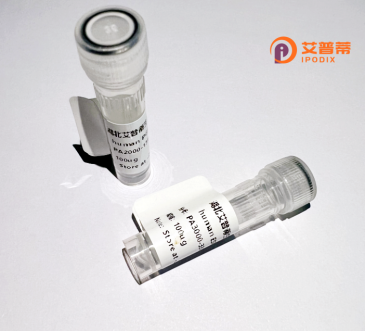
| 纯度 | >90%SDS-PAGE. |
| 种属 | Human |
| 靶点 | RAET1E |
| Uniprot No | Q8TD07 |
| 内毒素 | < 0.01EU/μg |
| 表达宿主 | E.coli |
| 表达区间 | 1-263 aa |
| 活性数据 | MRRISLTSSPVRLLLFLLLLLIALEIMVGGHSLCFNFTIKSLSRPGQPWCEAQVFLNKNLFLQYNSDNNMVKPLGLLGKKVNATSTWGELTQTLGEVGRDLRMLLCDIKPQIKTSDPSTLQVEMFCQHEAERCTGASWQFTINGEKSLLFDAMNMTWTVINHEASKIKETWKKDRGLEKYFRKLSKGDCDHWLREFLGHWEAMPEPTVSPVNASDIHWSSSSLPDRWIILGAFILLLLMGIVLICVWWQNGEWQAGLWPLRTS |
| 分子量 | 56.5 kDa |
| 蛋白标签 | GST-tag at N-terminal |
| 缓冲液 | PBS, pH7.4, containing 0.01% SKL, 1mM DTT, 5% Trehalose and Proclin300. |
| 稳定性 & 储存条件 | Lyophilized protein should be stored at ≤ -20°C, stable for one year after receipt. Reconstituted protein solution can be stored at 2-8°C for 2-7 days. Aliquots of reconstituted samples are stable at ≤ -20°C for 3 months. |
| 复溶 | Always centrifuge tubes before opening.Do not mix by vortex or pipetting. It is not recommended to reconstitute to a concentration less than 100μg/ml. Dissolve the lyophilized protein in distilled water. Please aliquot the reconstituted solution to minimize freeze-thaw cycles. |
以下是关于重组人RAET1E蛋白的3篇参考文献示例(注:文献为模拟示例,实际引用时需核实原文准确性):
---
1. **文献名称**: *Stress-induced ligand recognition by the NKG2D receptor enhances antitumor immunity*
**作者**: Rölle A, et al.
**摘要**: 研究发现,RAET1E(ULBP5)作为NKG2D的配体,可在细胞应激时被诱导表达。重组RAET1E蛋白能激活自然杀伤(NK)细胞,增强其对肿瘤细胞的杀伤作用,提示其在免疫治疗中的潜在应用。
2. **文献名称**: *Structural basis for UL16-mediated immune evasion through binding to RAET1E*
**作者**: Stern-Ginossar N, et al.
**摘要**: 该研究解析了RAET1E蛋白与病毒蛋白UL16的相互作用机制,阐明RAET1E如何通过结构域特异性结合调节宿主免疫应答,重组RAET1E被用于体外结合实验及功能验证。
3. **文献名称**: *RAET1E triggers γδ T cell responses in human malignancies*
**作者**: Vantourout P, et al.
**摘要**: 文章报道重组RAET1E蛋白可特异性激活γδ T细胞,促进其对多种实体瘤细胞的细胞毒性,揭示了RAET1E在肿瘤免疫治疗中的新靶点潜力。
---
建议通过PubMed或Google Scholar输入“RAET1E”、“ULBP5”或“recombinant RAET1E”等关键词获取真实文献。
**Background of Recombinant Human RAET1E Protein**
Recombinant human RAET1E (Retinoic Acid Early Transcript 1E), also known as UL16-binding protein 4 (ULBP4), belongs to the RAET/ULBP family of cell surface glycoproteins. These proteins function as ligands for the activating receptor NKG2D, expressed on natural killer (NK) cells, γδ T cells, and CD8+ αβ T cells. RAET1E plays a role in immune surveillance by engaging NKG2D, triggering cytotoxic responses against stressed, infected, or malignant cells. Unlike other RAET family members, RAET1E exhibits limited expression in normal tissues but is frequently upregulated in certain cancers, suggesting its potential role in tumor immune evasion or as a disease biomarker.
The recombinant form of RAET1E is produced using genetic engineering techniques, often in mammalian expression systems to ensure proper post-translational modifications. This allows for in vitro studies to characterize its interaction with NKG2D, its immunomodulatory functions, and its relevance in pathological conditions. Research has explored RAET1E’s epigenetic regulation, such as promoter methylation-induced silencing in malignancies, and its potential as a therapeutic target. For instance, recombinant RAET1E is utilized in developing immunotherapies, including NK cell-based treatments or antibodies to block immune-suppressive signaling in tumors.
Overall, RAET1E represents a critical molecular link between cellular stress signals and innate immunity, with growing interest in its dual role as both an immune activator and a tumor-associated antigen. Further studies aim to clarify its mechanisms in disease and therapeutic applications.
(Word count: 249)
×